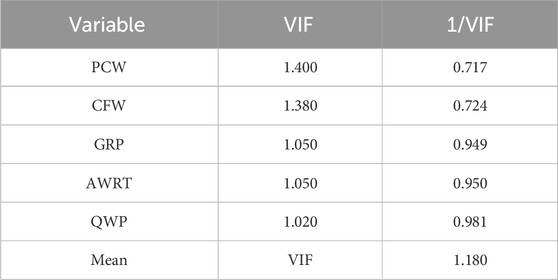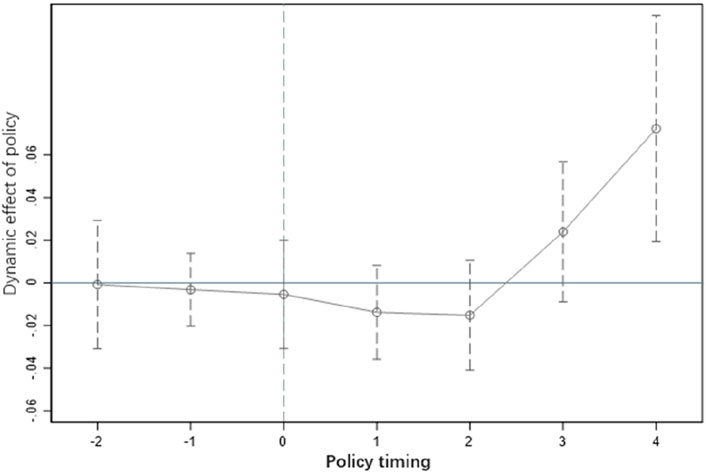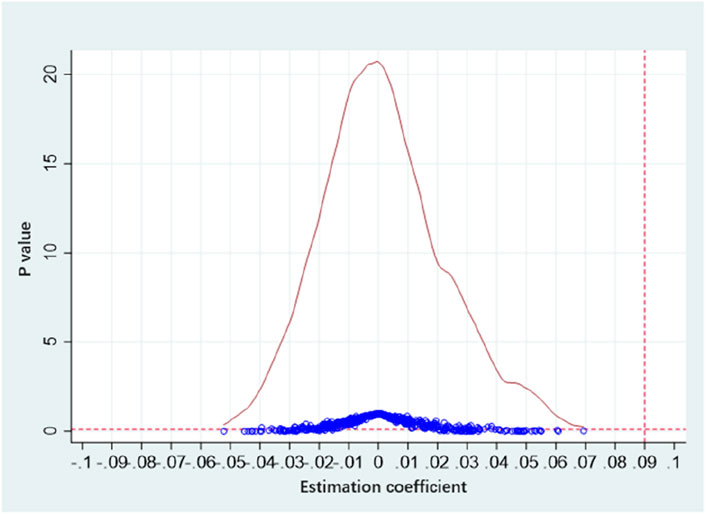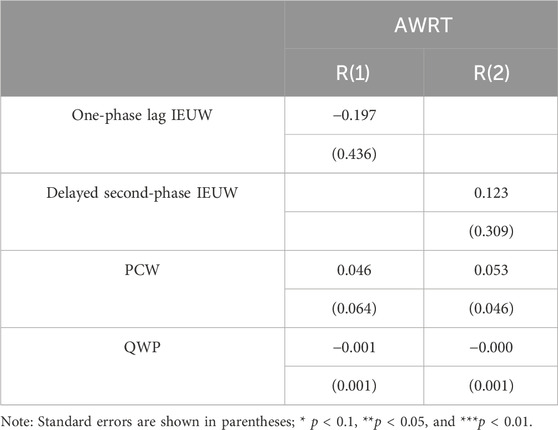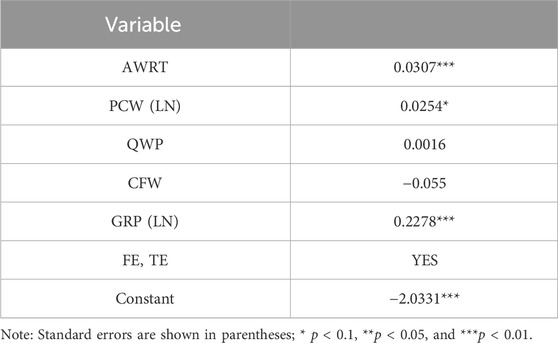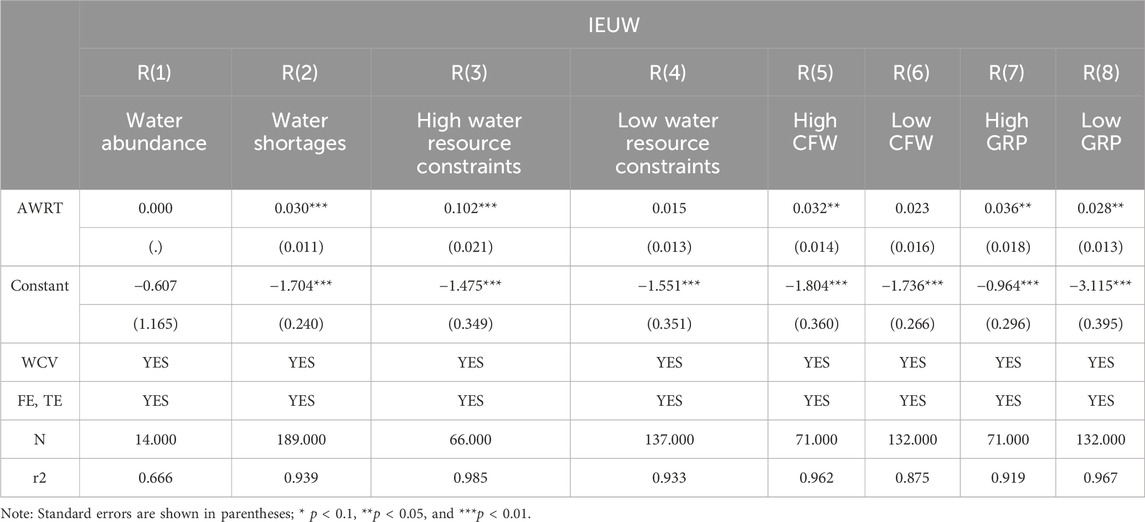- Business School, University of Jinan, Jinan, Shandong, China
Introduction: Improving the level of intensive and economical utilization of water resources is an important step towards water and food security.
Methods: Based on China’s provincial panel data from 2015 to 2021, this study uses a difference-in-differences (DID) model to examine the effect of agricultural water rights trading on intensive and economical utilization of water resources.
Results: The results show that agricultural water rights trading can significantly promote an intensive and economical utilization of water resources at the 1% level, and the results remain valid even after a series of robustness tests. Further analysis indicates that agricultural water rights trading can promote better utilization of water resources by significantly reducing agricultural water consumption at the 1% level and reducing the proportion of agricultural water consumption at the 5% level to optimize water use structure. Moreover, in regions with scarce water resources, strong water resource constraints, more farmland water conservancy projects, and greater economic development, the promoting effect of agricultural water rights trading on the intensive and economical use of water resources is more significant.
Discussion: This study provides evidence of the impact of China’s agricultural water rights trading policy and offers new ideas and experiences to improve China’s water resource utilization efficiency. The contributions of this work are mainly threefold. First, this paper clearly distinguishes the intensive conservation of water resources, presents an evaluation index system, and complements the existing literature on measuring the intensive and economical utilization of water resources. Second, the path of agricultural water rights trading is analyzed to improve the level of intensive and economical utilization of water resources, thus enriching related research on transmission mechanisms. Third, the heterogeneity of the influence of different regional conditions on the level of intensive and economical utilization of water resources is discussed to improve relevant policies.
1 Introduction
Water resources play an important role in production and life. However, with economic development, population increase, and changes in consumption patterns, the gap between the supply and demand of water resources has increased (Kampas et al., 2012) and the spatiotemporal distribution of water resources has become extremely unbalanced (Chen et al., 2023). Therefore, water shortages and spatiotemporal mismatches have gradually restricted the coordinated development of the Chinese economy. China’s agricultural water consumption accounts for approximately 60%–70% of the total economic water consumption; the effective utilization coefficient of farmland irrigation water as of 2022 was only 0.57, and there are still extensive and wasteful water use problems in China’s agricultural sector (Song et al., 2018; Huang et al., 2020). Rapid urbanization has led to a sharp increase in the urban population, along with increasing pressure on urban domestic water needs. At present, increasing the guarantee of industrial water and alleviating the pressure of water use are critical needs (Chen et al., 2021; Gerbens-Leenes and Nonhebel, 2004; Sun et al., 2022; Xue et al., 2017; Zhang et al., 2018). In 2022, the “Opinions on Accelerating the Construction of a National Unified Large Market” issued by the Central Committee of the Communist Party of China highlighted the need to promote the unification of the factor resource market and improve the related systems, which strongly supports the establishment of the water rights trading market and broadens the idea of realizing the intensive and economical utilization of water resources.
At present, there are three aspects to the research on the intensive and economical use of water resources in academic circles. The first aspect is the definition and measurement of such intensive and economical use of water resources. Intensive and economical utilization of water resources refers to the changes to extensive use of water resources through total water use control and quota management; moreover, it involves restraining unreasonable water demand through large-scale operation while greatly improving the efficiency and benefits of water resource utilization through the combination of water and other production factors. The first component of these efforts is the intensive utilization of water resources. Han and Huang (2020) believe that the intensive utilization of water resources emphasizes economic thinking, pays attention to the dynamic relationships between water resource input and output, and advocates the minimum input of water resources to obtain the maximum economic benefits. The second component is water conservation. Xiang and Qin (2020) noted that the core of water conservation is to maintain the stability of total water use, improve water use efficiency, and ensure the fair use of water resources (Li et al., 2022). Accordingly, Jiang (2021) built an evaluation index system for the intensive and safe use of water resources.
The second aspect involves the methods used to realize intensive and economical utilization of water resources. For example, Tian et al. (2022) found that water rights reforms can effectively promote agricultural water conservation by clarifying property rights and improving the water rights trading system to improve the overall efficiency of water resources utilization. In addition, agricultural water rights transactions can significantly promote intensive water conservation by the farmers by conveying policy information to them, changing their awareness of resource conservation, and intervening in their behavior (Wang et al., 2022). Yu and Cheng (2023), used the difference-in-difference (DID) model, and verified that the water rights pilot would improve the efficiency of water resource use through water rights transfer and technological innovation. The “Tragedy of the commons” is an important issue in the intensive and economical utilization of resources as well as the sustainable development of the economy and society. Therefore, accelerating the establishment of a sound water rights trading market is an important means to realize intensive and economical utilization of water resources, especially agricultural water rights trading markets. However, it is still debatable whether water rights trading can realize such intensive and economical use of water resources. Shen et al. (2020) believe that China’s water rights trading system is not yet perfect and that its market characteristics are not obvious. Moreover, due to the rebound effect of irrigation water consumption (Xu and Song, 2022), farmers may expand the irrigated areas or turn to high-water-consumption crops, for which water rights trading may not sufficiently realize the intensive and economical utilization of water resources.
The third aspect entails the analysis of the factors influencing the intensive and economical utilization of water resources. It has been found that water resource endowment is negatively correlated with the intensive and economical use of water resources, while the water resource protection system (Shen et al., 2020), farmland water conservancy construction, and economic development have positive impacts on the intensive and economical use of water resources (Ren and Dou, 2022; Yang and Xu, 2022; Qin et al., 2022).
In summary, current literature distinguishes between water resource intensification and conservation and assesses the degree of water resource intensification and safe utilization. Research has primarily focused on two methods to achieve intensive and economical water resource utilization through agricultural water rights trading, namely agricultural water conservation and water rights transfer as an intermediary. However, the evaluation index system for intensive water use and conservation is unclear; there is a lack of research on the steps to improve the level of intensive and economical water resource utilization through agricultural water rights trading, along with a lack of heterogeneity analysis of the influencing factors. This paper aims to investigate whether agricultural water rights trading can promote the intensive and economical utilization of water resources and their transmission path and to analyze the varying influences of regional conditions on the policy effects to provide guidance for promoting an intensive and economical utilization of water resources.
This study makes three contributions to the literature. First, our work provides a clear distinction between water resource intensification and conservation, builds the corresponding evaluation index systems, and complements the existing literature on the measurement of the intensive and economical utilization of water resources. Second, we analyze the transmission path of agricultural water rights trading to improve the level of water resource utilization, thus enriching the related research on transmission mechanisms. Third, by considering the differences in regional conditions that may cause variations in the effects of agricultural water rights trading policies, the heterogeneity of the impact of water resources endowment, water resources protection system, farmland water conservancy construction and economic development level on the level of intensive and economical utilization of water resources is deeply discussed in order to improve relevant policies.
2 Materials and methods
2.1 Measurement of the intensive and economical utilization of water resources
The intensive and economical utilization of water resources includes two aspects, namely intensive utilization (IU) and economical utilization (EU). IU focuses on the dynamic relationships between the input and output of water resources to improve their utilization efficiency (Xiang and Qin, 2020). Based on the comprehensive utilization efficiency of water resources and its components with respect to the agricultural, industrial, and living sectors, four indicators were considered based on the research results of Wang et al. (2022) to measure the IU of water: gross domestic product (GDP) output per cubic meter of water (WGO), water consumption per 10,000 Yuan of industrial added value (WCV), effective utilization coefficient of farmland irrigation water (EUF), and tap water penetration rate (TWP). The unilateral water GDP output is affected by the industrial structure, physical geography, and social economy of a region, and can reflect the comprehensive utilization efficiency of water resources to a certain extent, along with the input–output relationships of the water resources and water benefits. The WCV measure reflects industrial water benefits to a certain extent. The EUF reflects agricultural water benefits to some extent. The TWP score reflects the IU of domestic water.
EU emphasizes the improvement of water utilization efficiency and the increase in available water supply. The reuse rate of industrial water (RIW) reflects the degree of industrial water conservation. The average irrigation water consumption per mu (IWC) reflects the water savings in the agricultural sector. The utilization rate of recycled water (URW) reflects the water conservation of the urban residential sector. Therefore, based on the index construction method proposed by Jia and Liu (2011), three indexes were selected to measure water conservation, namely the RIW, IWC, and URW. The evaluation indexes for IU and EU are summarized in Table 1.
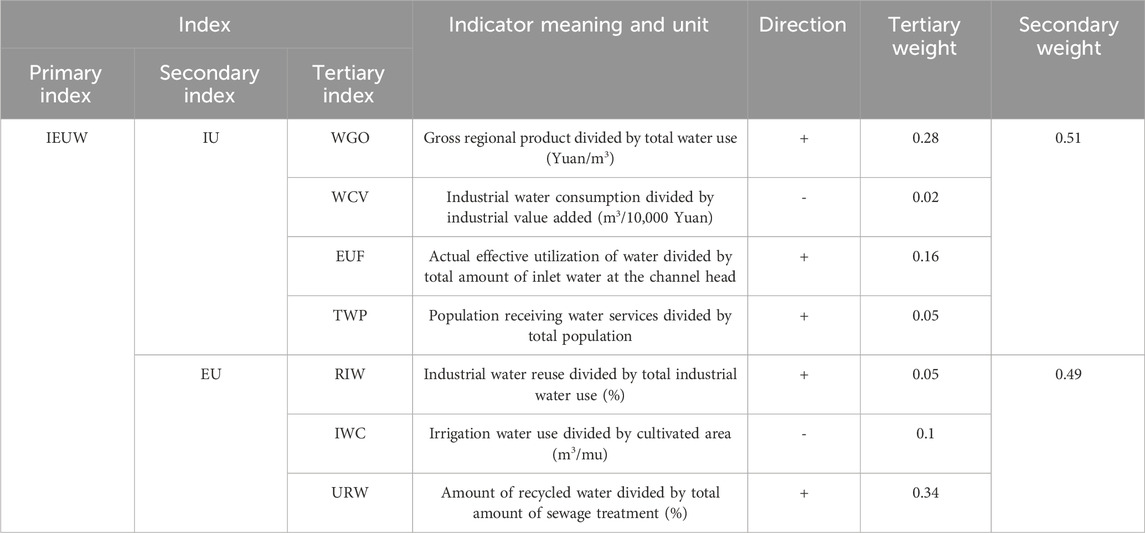
Table 1. Evaluation index system for intensive and economical utilization of water resources (IEUW).
2.2 Theoretical analysis
2.2.1 Analysis of agricultural water rights trading mechanisms to promote intensive and economical utilization of water resources
Agricultural water rights trading can promote an intensive and economical utilization of water resources by reducing agricultural water consumption and optimizing the water consumption structure. An intensive and economical utilization of water resources is necessary to ensure ecological and food security. From the perspective of the sellers of agricultural water rights (mainly farmers), such transactions can help realize the transfer of surplus irrigation water, compensate farmers for their income, and force them to change from extensive flood irrigation to intensive sprinkler/drip/other irrigation methods to reduce evaporation and leakage of irrigation water, thereby reducing agricultural water consumption, improving the utilization efficiency of water resources, and promoting water-saving technologies (Ma et al., 2021). From the perspective of the buyers of agricultural water rights, such transitions help realize cross-departmental and cross-regional water resource scheduling, enabling them to obtain the water required for consumption at a lower price; this not only promotes the transfer of water rights and the optimization of the water consumption structure but also enables them to invest more funds in the research and development of water-saving technologies (Ma et al., 2021), forming a positive feedback mechanism for the optimal utilization of water resources. Thus, we propose the following:
Hypothesis H1. Agricultural water rights trading can promote the intensive and economical use of water resources.
2.2.2 Agricultural water rights trading promotes the transmission path of intensive and economical utilization of water resources
First, agricultural water rights trading can help reduce agricultural water consumption. On the one hand, agricultural water rights trading encourages farmers to conserve water through income compensation, thereby changing the extent of agricultural water consumption. Owing to the exclusive use of farmland irrigation water resources during the transaction process, farmers’ surplus water can be converted into water rights according to the agreed price. Given the opportunity cost of agricultural water use, farmers will do their best to adopt more economical irrigation methods, thereby conserving water spontaneously (Liu et al., 2023). On the other hand, by transferring idle water rights to unused with high marginal benefits (Tian et al., 2020), agricultural water rights transactions allow new or potential water users the opportunity to obtain the resources they need. This is conducive to the improvement of water use efficiency and offers economic benefits to the entire society while providing the necessary economic and technical support for the sustainable utilization of agricultural water resources. The feeding of industry to agriculture can also promote the progress of agricultural water-saving technologies to further conserve water through a positive cycle of water conservation. Thus, we propose the following:
Hypothesis H2. Agricultural water rights trading promotes the intensive conservation of water resources by reducing agricultural water use.
Second, agricultural water rights trading can optimize the water consumption structure by promoting the transfer of farmers’ surplus water to other departments. Here, agricultural water rights trading encourages farmers to conserve water spontaneously through income compensation, thus enabling the application and promotion of water-saving technologies (Ma et al., 2021) and gradual changes to the farmers’ water use decisions; thus, the surplus water conserved by farmers can be transferred to other purposes, such as industrial and urban residential uses. Moreover, the industrial sector buys the surplus water at a lower price, not only meeting its own water demands but also retaining more funds to invest in industrial development and technology research and development to achieve greater industrial water efficiency. Finally, the technological progress achieved through industrial development and economic growth feeds agriculture, resulting in increased investment in farmland water-saving facilities and continuous development of agricultural water-saving technologies (Yao and Li, 2023); this again increases the efficiency of agricultural water usage to finally realize an optimized water use structure. Hence, we propose the following:
Hypothesis H3. Agricultural water rights trading promotes the intensive and economical utilization of water resources by optimizing the water consumption structure.
2.2.3 Heterogeneity analysis of agricultural water rights trading caused by regional differences
Given the uneven spatiotemporal distribution of water resources, water resources endowment, water resource constraint intensity, farmland water conservancy construction, and economic development, there may be differences in the effects of agricultural water rights trading.
First, the different water resource endowments may lead to the heterogeneity of the agricultural water rights trading effects. The water resource endowment of a region determines whether agricultural water rights can be traded. In some arid and semi-arid areas lacking water resources, water shortages may restrict development in all aspects of life. The implementation of agricultural water rights trading can promote water conservation and compensation for virtual water export of crops can increase the benefits of agricultural water use, and promote the intensive and economical utilization of water resources to enhance the competitiveness of economic benefits for agricultural production (Wang et al., 2017). However, some areas with abundant water resources may have low pressure for water demand; here, the cost of implementing agricultural water rights trading may be higher than the benefit, and the residents have poor water-conservation awareness, so the effects of agricultural water rights trading may be seriously weakened.
Second, differences in the intensity of the water resource constraint system may result in the heterogeneity of agricultural water rights trading effects. The word “system” is the most basic and core category of institutional economics, and it is also the behavioral restraint mechanism for economic entities in competition or cooperation (North, 1990). The system represents the maturity of the trading market and is the prerequisite for whether and to what extent water rights can be traded in the market. The more formalized the system, the less friction exists between two sides in a water rights transfer transaction, and the lower the transaction cost. In some areas that focus more on water resource protection and issue more protection documents, the transaction cost of agricultural water rights is relatively low, water use efficiency is higher, and policy implementation is better. However, in regions with fewer water resource protection documents, there may be more friction and higher transaction costs between the two sides of the agricultural water rights transaction, which weakens the effects.
Third, differences in the construction of farmland water conservancy facilities may lead to the heterogeneity of the effect of agricultural water rights trading. In agricultural development areas with more irrigation and water conservancy facilities, farmland can easily achieve large-scale planting management, and water-saving technologies such as sprinkler and drip irrigation are easier to implement and promote; thus, the promotion cost is low and the marginal income is high. The increase in farmland irrigation surplus water promotes agricultural water rights transactions (Qin et al., 2022). However, areas with fewer farmland water conservancy facilities may be more oriented to industrial and tertiary industrial development (Yao and Li, 2023); this makes it difficult to achieve large-scale farmland management, and the promotion of water-saving technologies may incur high costs and generate low income. Therefore, the amount of farmland irrigation water saved is small, while the effects of agricultural water rights trading are not obvious.
Fourth, differences in the level of economic development may also lead to the heterogeneity of the effect of agricultural water rights. Studies have shown that economic development improves the utilization efficiency of production resources. Industrial and domestic water demand in regions with greater economic development is generally higher; the funds and technologies in these regions can support agricultural water rights transactions, so that agricultural water can be transferred to the industrial and domestic sectors, thereby promoting intensive and economical utilization of water resources. However, it is difficult for regions with low economic development to provide conditions that support agricultural water rights trading, thus weakening the effects of agricultural water rights trading. Hence, we propose the following:
Hypothesis H4. Different regions have heterogeneous impacts of agricultural water rights trading on the conservation and intensive use of water resources.
Hypothesis H4a. Regions with different water resource endowments have heterogeneous impacts of agricultural water rights trading on the intensive and economical use of water resources.
Hypothesis H4b. Regions with different water resource constraints have heterogeneous impacts of agricultural water rights trading on the intensive and economical use of water resources.
Hypothesis H4c. Areas with different farmland water conservancy facilities have heterogeneous impacts of agricultural water rights trading on the intensive and economical use of water resources.
Hypothesis H4d. Regions with different levels of economic development have heterogeneous impacts of agricultural water rights trading on the intensive and economical use of water resources.
2.3 Agricultural water rights trading for the intensive and economical utilization of water resources
2.3.1 Samples and data
The research areas considered for this study include 29 provinces (municipalities) in China, and the timeframe of the study is from 2015 to 2021. Due to the lack of data on agricultural convenience in Shanghai and the lack of data on water resources in Tibet, these two regions were excluded. To analyze the impact of agricultural water rights trading on the intensive and economical utilization of water resources and its mechanisms, basic data were taken from the China Statistical Yearbook, China Water Resources Bulletin, China Environment Statistical Yearbook, China Urban Statistical Yearbook, Water Affairs Statistical Yearbook, Water Affairs Development Bulletin, and provincial water conservancy departments over the period of 2015–2021.
2.3.2 Variable selection
2.3.2.1 Explained variable: intensive and economical utilization of water resources
This paper considers two aspects of intensive and economical utilization of water resources, namely IU and EU.
2.3.2.2 Explanatory variable: agricultural water rights trading
Agricultural water rights trading is another explanatory variable in this study. Regions, where agricultural water rights are actually traded, were treated as the experimental group, and regions without such trading were considered as the control group. If a province (municipality) implemented agricultural water rights trading in a certain year, then its variable value from that year onward was 1; otherwise, the value was 0. The virtual variables for agricultural water rights trading in each region were collected manually according to the official website of the China Water Rights Exchange.
2.3.2.3 Mediating variables: agricultural water consumption and water consumption structure
Agricultural water consumption (AWC) can be reduced through the trading of agricultural water rights to improve the intensive and economical utilization of water resources. Data for this variable were derived from the China Statistical Yearbook. Water consumption structure (WCS) can be optimized through the trading of agricultural water rights by transferring any surplus water rights to non-agricultural sectors, such as industry, to improve the intensive and economical utilization of water resources. This variable is taken as the ratio of agricultural water consumption to industrial water consumption.
2.3.2.4 Control variables
Based on previous research (Tian et al., 2020; Lu et al., 2016), the other variables that affect the intensive and economical utilization of water resources, including water resource endowment, water resource constraints, irrigation and water conservancy constructions, and regional developments, were controlled in the regression analysis. First, per capita water resources (PCWs) were used to control the impact of water resource endowment on the intensive and economical utilization of water resources. Second, the number of water resource protection documents used in each region was considered to control for the impact of water resource constraints on the intensive and economical utilization of water resources. Third, the ratios of effective irrigated area to sown area of crops were used to control for the influences of irrigation and water conservancy construction on the intensive and economical utilization of water resources. Finally, gross regional development was used to control for the influence of regional development on the intensive and economical utilization of water resources. Table 2 shows the descriptions of all variables used in the regression model and their descriptive statistics.
2.3.3 Econometric model
The implementation of agricultural water rights trading is considered a quasi-natural experiment, and the DID method was used to identify the impact of agricultural water rights trading on the intensive and economical utilization of water resources. Since the implementation of agricultural water rights trading occurred at different times in different provinces, a multiperiod differential model regression was adopted herein. Thus, we built the following econometric model:
where waterjt represents the intensive and economical utilization of water resources in province j in the year t as the explained variable. Next, didjt represents the dummy variable for the implementation of agricultural water rights trading in province j in year t; if agricultural water rights trading is implemented in a locality, the value of this variable is 1 for the year in which the policy is implemented and thereafter; otherwise, the value is 0. Xjt is a set of control variables used to control for other factors affecting the intensive and economical utilization of water resources; λt is the annual fixed effect; σj is the provincial fixed effect; εjt is the error term; α is a constant term; γ is the coefficient of the control variable; β is the coefficient of the core explanatory variable that represents the direction and degree of influence of agricultural water rights trading on the level of intensive and economical utilization of water resources in each region.
3 Results and discussion
3.1 Baseline regression results
In this paper, Stata 16 software was used to process the data. To exclude any multicollinearity between the variables, a collinearity diagnosis was carried out; these results are shown in Table 3, and no collinearity problems were observed. According to the results of the Hausman test, the fixed effect model was selected for regression, and the results of the baseline regression model are shown in Table 4. In regression (1) without any control, the results show that agricultural water rights trading significantly promotes the intensive and economical utilization of water resources at the 1% level. In regression (2) with added annual and provincial fixed effects, the results show that agricultural water rights trading significantly promotes the intensive and economical utilization of water resources at the 1% level. In regression (3), for every 1% increase in agricultural water rights trading, the level of intensive and economical utilization of water resources increases by 0.031%, indicating that the results are still significant when other influencing factors are controlled; thus, agricultural water rights trading promotes the intensive and economical utilization of water resources, proving Hypothesis H1.

Table 4. Agricultural water rights trading (AWRT) for intensive and economical utilization of water resources (IEUW).
3.2 Robustness check
3.2.1 Parallel trend test
The DID model was used in this work to evaluate the impact of agricultural water rights trading on the intensive and economical utilization of water resources, but one of the prerequisites for the effectiveness of the DID approach is that if there was no external impact from agricultural water rights trading, then the control group was parallel to the developmental trend of intensive and economical utilization of water resources of the experimental group. To this end, we conducted the following parallel trend test.
Based on previous literature, the trend test was conducted using the event research method, as shown in Figure 1, where the horizontal axis represents the policy implementation time. The results indicate that before the policy implementation (i.e., −2, −1, 0), the trading variables of the agricultural water rights were not significant and the parallel trend hypothesis was verified, which may be due to the short implementation time of the agricultural water rights trading policy, which caused a lag effect.
3.2.2 Post-event dynamic effect analysis
The post-event dynamic effect analysis emphasizes the differences in effects between different years following policy implementation. If the differences are significant, then it indicates that the policy implementation produced certain sustained effects. As can be seen in Figure 1, after policy implementation (i.e., 1, 2, 3, 4), the transaction variables of the agricultural water rights were found to be significant from the second year onward, indicating sustained policy effects.
3.2.3 Placebo test
A placebo test was performed to exclude the influence of other factors on the estimated results. Specifically, 6 out of the 27 provinces were randomly selected for the implementation of agricultural water rights trading as the “pseudo” test group; the remaining samples were selected as the control group from a randomly selected year between 2015 and 2021 as the implementation year of agricultural water rights trading; then, the placebo virtual policy variable DID was generated, and Eq. (1) was used for estimation. This process was repeated 500 times. Since the pseudo-trial group was randomly generated and did not have a significant impact on the explained variables, its estimation coefficient was expected to be around 0. As shown in Figure 2, the regression coefficient of the randomized trial was around 0, and the actual estimation coefficient represented by the vertical line in the figure was an outlier in the distribution of the placebo test coefficients. Therefore, it can be judged that there is no obvious missing variable bias in the estimation results of this paper. The results of the placebo test conclusively indicate that agricultural water rights trading promotes robust and intensive conservation of water resources and that this promoting effect is not influenced by other unobserved random factors.
3.2.4 Endogenetic analysis
To solve the endogeneity problem, reverse causality was first excluded. Low levels of water conservation often imply higher water consumption (especially in agriculture), lower agricultural productivity, and lower technological advances, which may encourage local governments to engage in agricultural water rights trading. Therefore, it is necessary to examine whether the level of water conservation affected the implementation of agricultural water rights trading. Here, the implementation of agricultural water rights trading was taken as the explained variable, and the intensive and economical utilization of water resources in provinces (municipalities) lagging by one and two stages was taken as the explanatory variable for regression. The regression results are shown in Table 5 and are not significant, indicating that there is no causal relationship between the two variables; this means that the intensive and economical utilization of water resources is not the main reason for implementing agricultural water rights trading, thus excluding issues related to reverse causality.
3.2.5 Propensity score matching difference-in-difference (PSM-DID) test
Since agricultural water rights trading is not completely randomized, there may not be comparability between the experimental and control groups. To eliminate the influence of sample selection bias on the estimation results of the benchmark model, we used the PSM-DID method to perform K-nearest neighbor matching between the two groups, followed by regression based on the matched data. These results are summarized in Table 6 and show that the estimated coefficient of the virtual interaction for agricultural water rights transactions was positive and significant at the 1% level, indicating that agricultural water rights transactions have a significant positive impact on the intensive and economical utilization of water resources. This finding is consistent with the baseline regression results, indicating that the results are robust; this means that agricultural water rights trading can significantly promote the intensive and economical use of water resources.
3.3 Mechanism analysis
The above empirical study shows that agricultural water rights trading has a significant positive impact on the intensive and economical utilization of water resources. Naturally, we should further consider the mechanisms through which agricultural water rights trading produces an impact. Herein, we discuss the impact of agricultural water rights trading mechanisms on the intensive and economical utilization of water resources from the perspective of agricultural water consumption and water consumption structure. To this end, we built the following measurement model:
In Eqs. (2–4), medjt represents the mediating variables, including agricultural water consumption and water consumption structure (i.e., the proportion of agricultural to industrial water consumption), while the other symbols are the same as in Eq. (1).
The first two columns of Table 7 show the results for the mechanisms that reduce agricultural water consumption. The regression results based on Eq. (3) indicate that agricultural water rights trading significantly reduces agricultural water consumption at the 5% level, which is consistent with the results reported by Yao and Li (2023) and Fang and Zhang (2020). The regression results based on Eq. (4) indicate that agricultural water consumption is significant at the 1% level with a negative coefficient, indicating that agricultural water rights trading can improve the utilization of water resources by reducing agricultural water consumption. This shows that agricultural water consumption has a partial mediating effect, thus confirming Hypothesis H2.
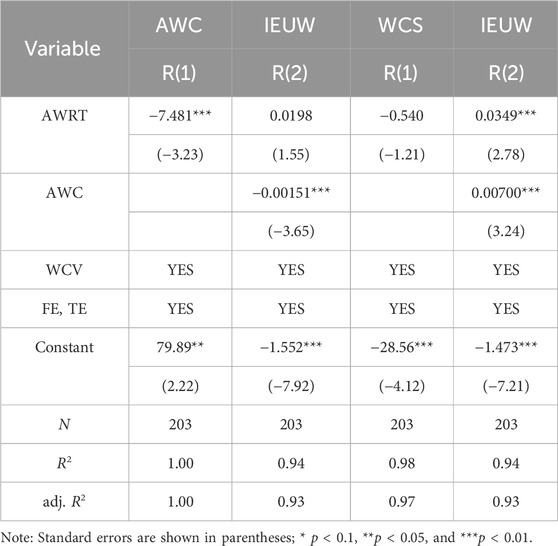
Table 7. Regression results of agricultural water consumption mechanisms and water consumption structure.
The last two columns of Table 7 show the results for the mechanisms optimizing the water consumption structure, and bootstrap tests were carried out on these intermediary effects. The test results indicate that agricultural water rights trading significantly reduces the proportion of agricultural water consumption, thereby optimizing the water consumption structure and improving the utilization of water resources at the 5% level by transferring agricultural water-saving rights to non-agricultural sectors such as industry. Thus, Hypothesis H3 is confirmed.
3.4 Heterogeneity analysis
3.4.1 Differences in water endowment
As noted above, agricultural water rights trading does not always promote the intensive and economical use of water resources. In areas with abundant water resources, residents’ awareness of minimal water conservation is low; hence, the demand for water rights trading is lacking and the trading mechanism is not perfect. This means that the cost of implementing water rights trading is high, so the effect of agricultural water rights trading on an intensive and economical utilization of water resources may not be ideal. However, in areas with water shortages, the demand for water resources is high and the water resources themselves are poor, so agricultural water rights trading can promote the intensive and economical use of water resources. To verify the heterogeneity of policy effects caused by differences in water resource endowments, samples were grouped according to the mean PCW values. Samples with values higher than the mean were assigned to the water resource abundance group while samples with values lower than the mean were assigned to the water resource scarcity group before performing the grouped regression. These regression results are shown in Table 8; The regression (2) results show that agricultural water rights trading is significant at the 1% level and positive, indicating that the implementation of agricultural water rights trading can significantly improve the level of intensive and economical utilization of scarce water resources. Thus, Hypothesis H4a is valid.
3.4.2 Differences in water resource constraints
Differences with regard to water resource constraints affect the level of intensive conservation of water resources. Therefore, it is necessary to consider whether the degree of attention to water resources in each province affects policy outcomes. Thus, the samples were grouped according to the mean number of water resource constraint documents in each province. Samples higher than the mean were assigned to the high water resource constraint group while samples lower than the mean were assigned to the low water resource constraint group before performing regression. These regression results are shown in Table 8; here, the regression (3) results show that agricultural water rights trading is significant and positive at the 5% level, indicating that the implementation of agricultural water rights trading can significantly improve the level of intensive and economical utilization of water resources in areas with high water resource constraints. Thus, Hypothesis H4b is valid. This is because the stronger the water resource constraints, the better the effects of agricultural water rights trading policy implementation, which can significantly promote the intensive and economical utilization of water resources.
3.4.3 Differences in irrigation and water conservancy construction
Differences in irrigation and water conservancy constructions among the provinces may also lead to heterogeneity of policy effects. Therefore, the samples were grouped according to the mean value of irrigation and water conservancy construction in each province, and provinces with higher than the mean values were classified as high irrigation and water conservancy construction areas while those with lower than the mean values were classified as low irrigation and water conservancy construction areas. The corresponding regression results are shown in Table 8; The regression (5) results show that agricultural water rights transaction are significant and positive at the 5% level, indicating that implementation of agricultural water rights trading can significantly improve the intensive and economical utilization of water resources in areas with higher farmland water conservancy constructions. This result is consistent with the findings of Qin et al. (2022), thus Hypothesis H4c is valid. This is because more farmland water conservancy construction means more convenient trading of agricultural water rights.
3.4.4 Differences in levels of economic development
To analyze the heterogeneity of economic development on policy effects, the sample provinces were grouped according to their mean regional GDP during the sample period from 2015 to 2021. Samples higher than the mean were classified into the high economic development group while samples lower than the mean were classified into the low economic development group. The corresponding regression results are shown in Table 8; The regression results (7) show that agricultural water rights trading is significant and positive at the 1% level, indicating that the implementation of agricultural water rights trading can significantly improve the level of intensive and economical utilization of water resources in areas with high levels of economic development. The results of regression (8) show that agricultural water rights trading is significant and positive at the 1% level, indicating that its implementation has a positive effect on the intensive and economical utilization of water resources in areas with low levels of economic development. Moreover, the promoting effect of agricultural water rights trading on the intensive and economical utilization of water resources is stronger in regions with high levels of economic development than in regions with low levels of economic development. Thus, Hypothesis H4d is valid.
4 Limitations
In light of the aforementioned benefits, this paper also has some limitations in terms of whether and how the trading of agricultural water rights affects the intensive and economical utilization of water resources. This paper considers agricultural water rights transactions as the core explanatory variable; however, published data lack information such as transaction frequency and transaction unit price, so it is impossible to discuss the impact of the degree and scale of agricultural water rights transactions on the utilization of water resources. In addition, due to this lack of data, cross-regional agricultural water rights trading has not been differentiated and discussed in detail, which affects the outcome of policy implementation to a certain extent. If relevant data are made available in the future, they can be used to differentiate and discuss the internal effects of agricultural water rights trading and the effects of interprovincial flow.
5 Conclusion
Based on the data of 29 provinces (municipalities) in China from 2015 to 2021, this paper adopted the DID method for empirical assessment to show that 1) agricultural water rights trading can significantly promote the intensive and economical utilization of water resources, which would be valid even after robustness tests; 2) from an actionable perspective, agricultural water rights trading improves the utilization of water resources by reducing agricultural water consumption and optimizing the water consumption structure; 3) in the heterogeneity analysis, the impact of agricultural water rights trading on the utilization of water resources is are greater in areas with water resources shortages, strong water resource constraints, more farmland water conservancy construction, and more economic development. Hence, this paper validates the significance of agricultural water rights trading with regard to the intensive and economical utilization of water resources, enriches the research efforts in related fields, and provides the corresponding theoretical basis and policy highlights for promoting the intensive and economical use of water resources in various regions. The following are some suggestions based on the findings of this study.
First, agricultural water rights trading must be continuously promoted to improve market activity. In particular, agricultural water rights trading significantly contributes to the intensive and economical utilization of water resources by reducing agricultural water consumption. Next, water rights trading implementation must be accelerated to boost the willingness and confidence of farmers, in addition to enhancing farmers’ awareness regarding intensive water conservation.
Second, the stringent regulations on water resources must be reinforced and the regulatory functions of the government must be maximized. As a form of “public good,” excessive utilization of water resources can result in public land disasters. Therefore, it is imperative that the government provides proactive guidance, prioritizes water resource conservation, and enhances public awareness of water conservation through policy-based education. Furthermore, the government should offer comprehensive guidance and supervision for the water rights trading market to establish more robust market conditions conducive to agricultural water rights trading.
Finally, the implementation of agricultural water rights trading must comprehensively consider the economic and management capabilities of each region, consider the supervision and transaction costs, and expand the feasibility of agricultural water rights trading based on local conditions. For example, in areas where law enforcement regarding water rights is weak, flexible water prices should be set according to the regional supply and demand structure of agricultural water resources, agricultural development level and farmers’ bearing capacity. In addition, areas with low economic development should be offered guidance on the experience of water supply rights trading and water-saving technologies to effectively ensure the outcomes of agricultural water rights trading.
Data availability statement
The datasets presented in this study can be found in online repositories. The names of the repositories and accession numbers can be found below: China Statistical Yearbook, China Water Resources Bulletin, China Environment Statistical Yearbook, China Urban Statistical Yearbook, Water Affairs Statistical Yearbook, and Water Affairs Development Bulletin.
Author contributions
LR: formal analysis, methodology, project administration, supervision, and writing–review and editing. XC: data curation, investigation, software, and writing–original draft.
Funding
The authors declare that financial support was received for the research, authorship, and/or publication of this article. This research was funded by the National Social Science Project “Research on the large-scale transaction and its effect of right-to-household agricultural water right” (18BJY075) and the Shandong Social Science Project “Research on the influence mechanism of water resource constraint on the industrial linkage of the three economic circles in Shandong province.”
Conflict of interest
The authors declare that the research was conducted in the absence of any commercial or financial relationships that could be construed as a potential conflict of interest.
Publisher’s note
All claims expressed in this article are solely those of the authors and do not necessarily represent those of their affiliated organizations, or those of the publisher, the editors, and the reviewers. Any product that may be evaluated in this article, or claim that may be made by its manufacturer, is not guaranteed or endorsed by the publisher.
References
Chen, S., Wang, X. Y., and Yao, S. B. (2023). National water-saving city and its impact on agricultural total factor productivity: a case study of nine provinces along the Yellow River. China. J. Clean. Prod. 417, 138019. doi:10.1016/j.jclepro.2023.138019
Chen, S. J., Cao, Y. Y., and Li, J. (2021). The effect of water rights trading policy on water resource utilization efficiency: evidence from a quasi-natural experiment in China. Sustainability 13 (9), 5281. doi:10.3390/su13095281
Fang, L., and Zhang, L. (2020). Does the trading of water rights encourage technology improvement and agricultural water conservation? Agric. Water Manag. 233 (2), 106097. doi:10.1016/j.agwat.2020.106097
Gerbens-Leenes, P. W., and Nonhebel, S. (2004). Critical water requirements for food, methodology and policy consequences for food security. Food Policy 29, 547–564. doi:10.1016/j.foodpol.2004.09.003
Han, Y. P., and Huang, H. P. (2020). Intensive utilization of water resources: concept, connotation and model.China. Water. Resour. 13, 43–44.
Huang, G., Hockstra, A. Y., Krol, M. S., Jagermeyr, J., Galindo, A., Yu, C., et al. (2020). Water-saving agriculture can deliver deep water cuts for China. Resour. Conserv. Recycl. 154, 104578. doi:10.1016/j.resconrec.2019.104578
Jia, F. L., and Liu, Y. Z. (2011). Evaluation index system establishment for water conservation and countermeasures. J. Arid. Land. Resour. Environ. 25 (06), 73–78. doi:10.13448/j.cnki.jalre.2011.06.001
Jiang, W. L. (2021). Strategic path of intensive and safe utilization of water resources in China. China. Water. Resour. 06, 58–59.
Kampas, A., Petsakos, A., and Rozakis, S. (2012). Price induced irrigation water saving: unraveling conflicts and synergies between European agricultural and water policies for a Greek Water district. Agric. Syst. 113, 28–38. doi:10.1016/j.agsy.2012.07.003
Li, S., Zhang, R. J., and Jiang, X. H. (2022). Legislative research on water resources economic and intensive use system. Yellow River 44 (02), 65–70. doi:10.3969/j.issn.1000-1379.2022.02.014
Liu, S. L., Teng, C. G., and Wang, T. X. (2023). Influence of information acquisition channels on farmers’ water-saving behaviors. Res. Agric. Mod. 44 (02), 328–338. doi:10.13872/j.1000-0275.2023.0012
Lu, Y., Zhang, X., Chen, S., Shao, L., and Sun, H. (2016). Changes in water use efficiency and water footprint in grain production over the past 35 years: a case study in the North China Plain. J. Clean. Prod. 116, 11671–11679. doi:10.1016/j.jclepro.2016.01.008
Ma, J. J., Cui, Y., Kong, X. Z., and Chen, Z. G. (2021). Water rights system, water drawing permission and farmers’ adoption of water-saving technology—an empirical study on water-saving effects of water rights reforms based on the difference approach. Statis. Res. 38 (04), 116–130. doi:10.19343/j.cnki.11-1302/c.2021.04.009
North, D. C. (1990). Institutions, institutional change, and economic performance. Cambridge: Cambridge University Press.
Qin, T., Tong, J. P., and Zhi, Y. L. (2022). Influence and effect of water rights trading mechanism on agricultural water use efficiency. J. Nat. Resour. 37 (12), 3282–3296. doi:10.31497/zrzyxb.20221217
Ren, B. P., and Dou, Y. B. (2022). Water rights market construction and resources utilization in the Yellow River basin. J. Xi’an Uni. Financ. Econo. 35 (01), 5–14. doi:10.19331/j.cnki.jxufe.20210813.002
Shen, D. J., Ali, G. N., and Chen, C. (2020). Water rights system in the Yellow River basin: problems, challenges, and suggestions. Resour. Sci. 42 (01), 46–56. doi:10.18402/resci.2020.01.05
Song, J. F., Guo, Y. N., Wu, P. T., and Sun, S. K. (2018). The agricultural water rebound effect in China. Ecol. Econ. 146, 497–506. doi:10.1016/j.ecolecon.2017.12.016
Sun, F. H., Zhang, L. L., Lu, B., and Shen, J. Q. (2022). Evaluation of China’s provincial industrial water efficiency and analysis of regional differences. J. Econ. Water. Resour. 40 (01), 21–28+85-86. doi:10.3880/j.issn.1003-9511.2022.01.004
Tian, G. L., Sheng, Y., and Lu, X. (2020). On the influence of water rights trading market operation on water resource use efficiency in pilot areas. China. Popul. Resour. Environ. 30 (06), 146–155. doi:10.12062/cpre.20200119
Tian, G. L., Zhao, Q. Y., and Wu, Z. (2022). Water-saving effects of water right reform under the rural vitalization strategy and its impact on water efficiency. China. Popul. Resour. Environ. 32 (12), 193–204. doi:10.12062/cpre.20220434
Wang, H. R., Li, Y. Y., and Yang, Y. F. (2022). Construction and application of evaluation model for intensive and safe utilization of water resources. Water. Resour. Prot. 38 (01), 18–25. doi:10.3880/j.issn.1004-6933.2022.01.003
Wang, Y. B., Liu, D., Cao, X. C., Yang, Z. Y., Song, J. F., Chen, D. Y., et al. (2017). Agricultural water rights trading and virtual water export compensation coupling model: a case study of an irrigation district in China. Agric. Water Manag. 180, 99–106. doi:10.1016/j.agwat.2016.11.006
Xiang, W., and Qin, P. (2020). Application of the concept of economical and intensive utilization in water resources protection legislation of the Yellow River. Environ. Prot. 48 (Z1), 47–49. doi:10.14026/j.cnki.0253-9705.2020.z1.008
Xu, H., and Song, J. F. (2022). Drivers of the irrigation water rebound effect: a case study of Hetao irrigation district in Yellow River basin, China. Agric. Water Manag. 266, 107567. doi:10.1016/j.agwat.2022.107567
Xue, J., Guan, H., Huo, Z., Wang, F., Huang, G., and Boll, J. (2017). Water saving practices enhance regional efficiency of water consumption and water productivity in an arid agricultural area with shallow groundwater. Agric. Water Manag. 194, 78–89. doi:10.1016/j.agwat.2017.09.003
Yang, Q., and Xu, Q. (2022). Research on comparison of green efficiency of water resources between yangtze river economic Belt and Yellow River basin. Rev. Econo. Manag. 38 (05), 49–62. doi:10.13962/j.cnki.37-1486/f.2022.05.004
Yao, P., and Li, H. Z. (2023) Can agricultural water rights trade promote agricultural green development? Chinese Rural Econ. 02, 17–40. doi:10.20077/j.cnki.11-1262/f.2023.02.010
Yu, L. H., and Cheng, S. J. (2023). Can the ecological protection compensation system improve regional water use Efficiency? An empirical study based on water right pilot. J. Finan. Econ. 49 (02), 19–33. doi:10.16538/j.cnki.jfe.20220614.203
Keywords: irrigation, propensity score matching difference-in-differences, water consumption structure, water management, water resource constraint
Citation: Rong L and Cheng X (2024) Can agricultural water rights trading promote intensive and economical utilization of water resources in China based on the difference-in-differences model?. Front. Environ. Sci. 12:1413423. doi: 10.3389/fenvs.2024.1413423
Received: 07 April 2024; Accepted: 19 September 2024;
Published: 11 October 2024.
Edited by:
La Zhuo, Northwest A&F University, ChinaReviewed by:
Thomas Ramsey, China Three Gorges University, ChinaArbind Kumar Patel, Jawaharlal Nehru University, India
Copyright © 2024 Rong and Cheng. This is an open-access article distributed under the terms of the Creative Commons Attribution License (CC BY). The use, distribution or reproduction in other forums is permitted, provided the original author(s) and the copyright owner(s) are credited and that the original publication in this journal is cited, in accordance with accepted academic practice. No use, distribution or reproduction is permitted which does not comply with these terms.
*Correspondence: Lili Rong, bHJnNTE4QDEyNi5jb20=; Xin Cheng, Njc0Mjc5MzE5QHFxLmNvbQ==
 Lili Rong
Lili Rong Xin Cheng
Xin Cheng
